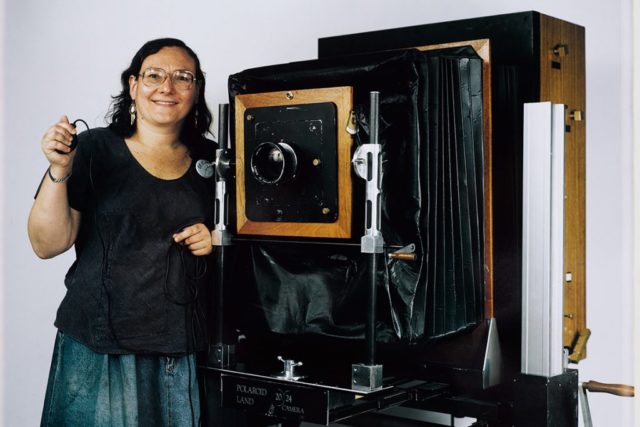
Elsa Dorfman isn’t interested in your soul; your surface is more than enough. And since the 1960s, Dorfman has photographed those surfaces with love and care from her studio in Cambridge, Massachusetts.
And in Errol Morris’s latest documentary, The B-Side: Elsa Dorfman’s Portrait Photography, Dorfman’s love and care bewitches Morris’s camera and transfixes the audience. Here is an artist with an unadulterated joy for life, one she spent her life capturing with a camera. As the 80-year-old tells Morris, she’s never been interested in taking photos of sad people. “Life is hard enough,” Dorfman says. “You don’t need to walk around with a picture of it.”
Morris’s doc takes a similar approach; maybe because this approach best complements Dorfman’s personality, or maybe because Morris fell under her spell, her outlook, her approach to photography and her magical Massachusetts accent.
Dorfman, a self-described “nice Jewish girl,” picked up her first camera in the ’60s and immediately fell in love with the identity it brought her. As she points out, a woman was either someone’s wife or someone’s mother. But with a camera in her hand, Dorfman was a photographer. An identity no one could take away.
Flash forward to 1980: the Polaroid company has released the large format camera, which produces 20-by-24-inch images. Only a select few were allowed to use the specialty camera, and Dorfman was not in with the in-crowd. “They referred to me as the nag,” Dorfman recalls with a smile, remembering how she bugged Polaroid until they relented and allowed her to use the camera. And from her first photos in the ’80s to the end of Polaroid in 2008, Dorfman was known for these large format portraits.
The title, The B-Side, comes from Dorfman’s own archive. When commissioned to take family portraits, Dorfman always took at least two photos per session. Like a 45 record, the one the family selected was the A-side. The one left with Dorfman was the B-side. In some instances, the B-side is a development or a lighting error. Other times it is simply a child acting out or a couple blinking. The A-side might look best in your home but for Dorfman, the B-side is like snatching magic out of the air.
The B-Side debuted last September at Colorado’s prestigious Telluride Film Festival with Morris and Dorfman in attendance. Also on last year’s schedule: California Typewriter, a documentary love letter to the writer’s mechanical companion.
Watching both films, one cannot help but wonder what the future has in store for our current technology. Will we wax nostalgically about Mac Powerbooks? What about the proliferation of camera phones, Polaroid’s unwitting successor? Is there a future documentary about an Instagram photographer? Probably. Technology is nothing more than what the artists use to express themselves. As Dorfman points out, the disposable dollar camera wasn’t just popular in the ’60s because it was new; it affordably “showed people how to take pictures.”
Some of those pictures wound up in shoeboxes and family photo albums. Dorfman’s will hang on the wall of a museum. Funny how these things happen.
On the Bill: The B-Side: Elsa Dorfman’s Portrait Photography. Opens July 21. Landmark Chez Artiste, 2800 S. Colorado Blvd., Denver, 303-758-3496, landmarktheatres.com.














